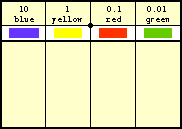
| Start with definitions: blue tiles represent tens, yellow tiles represent ones/units, red tiles represent tenths, green tiles represent hundredths. | |
| Try building a set of blocks which represents each of the following: 3.24 5.96 10.01 11.12 99.00 0.30 |
|
| Create a page like the one shown to serve as an addition mat. | |
| To model 4.32 + 3.28, in the ones column place 4 yellow tiles, in the tenths column place 3 red tiles, and in the hundredths column place 2 green tiles. Now ... add 3 yellow tiles to the ones column, 2 red tiles to the tenths column, and 8 green tiles to the hundredths column. Regroup (remember, only a maximum of ten tiles in a given column). |  |
| Try modeling each of the following: 5.43 + 0.93 13.56 + 8.77 | |


